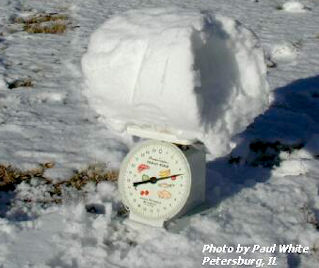| Looking
across the open, snow-covered cornfield, they appear, on first glance, as if someone
started to build snowmen or a snow fort then left the rolled balls of snow randomly
across the field. And, although they each have a distinct "roll-up"
track, close inspection show no footprints in the surrounding snow. Are these
the winter version of crop circles, the work of winter spirits, or a curious product
of nature? People
in Central Illinois observed this strange phenomenon in February, 2003, for the
first time in over 40 years. Log-shaped "snowballs" showed up on lawns,
fields, and other open areas. This is a phenomenon referred to as "snow rollers"
which are formed under specific weather conditions: The
ground surface must have an icy, crusty snow, on which falling snow cannot stick.
About
an inch or so of loose, wet snow must accumulate.
Gusty and strong winds are
needed to scoop out chunks of snow. Snowfall
of 1 to 4 inches occurred across central Illinois the morning of February 11,
2003. That evening, as a strong cold front pushed through the area, wind gusts
of 40 to 60 mph were noted in many areas. Once the initial "seed" of
the roller is started, it begins to roll. It collects additional snow from the
ground as it rolls along, leaving trails behind it. The appearance is similar
to building snowmen, except the snowball is more log-shaped rather than spherical,
and many times they are hollow. They can be as small as a golf ball, or as large
as a 30 gallon drum, but typically they are about 10 to 12 inches in diameter. Here
are several photographs of these snow rollers: 
 
In
this
combination of weather conditions, the snow is blown and simply rolls. If the
wind is strong enough, the moving clump of snow becomes cylindrical, often with
a hole through it lengthwise. Their size may range from that of eggs to small
barrels. The tracks that they make are usually several feet long and less than
3 inches deep. The snowroller's path can be straight ahead or erratic depending
on how the gusty wind pushes the roller along. Sloped terrain may also assist
in the formation and movement of the snowroller seed as the force of gravity assists
the wind force pushing on the rolling snow body. Snow rollers in populated areas
may be mistaken as being made by children.
From
... www.CRH/NOAA.gov |